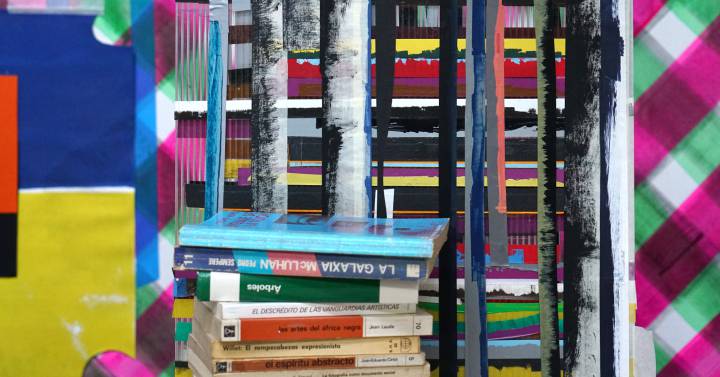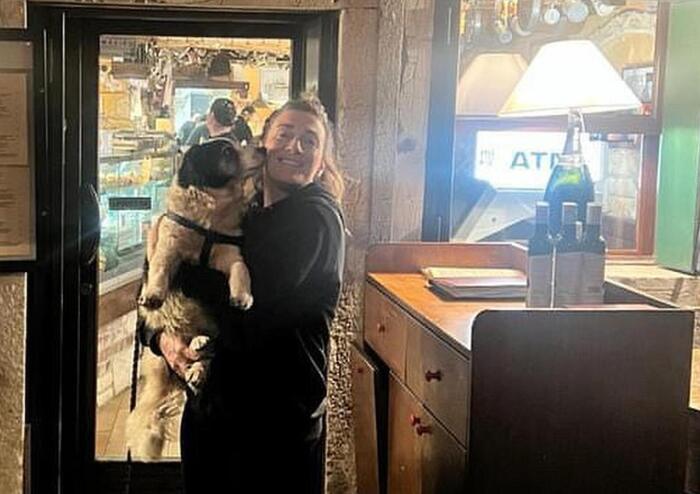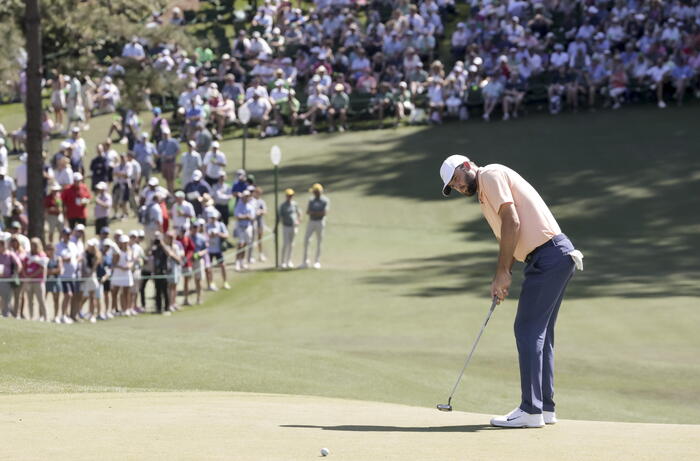Juan Uslé (Santander, 1954) spends most of his time in his studio, enclosed in canvas.
Between works composed of rhythmic abstractions where a dialogue is established between elements of an opposite nature.
Labyrinths built by discontinuous brush strokes repeated countless times that enclose intellectual and emotional processes, and provide open spaces for the spectator's imagination.
However, his recognition as one of the Spanish painters with the most international projection has not been enough for Juan Uslé to stop refusing "to be Juan Uslé".
Hence, in his studio there is always his camera, a Canon that he carries on his back in any kind of movement, and through which he proposes a new look where his obsessions as a creator are inevitably reflected.
Photography thus contributes to deepening his language, free from pictorial constraints but not entirely independent.
In this way, from this continuous looking, from the need of its author to capture subtleties, the fragility that escapes, and delve into the complexity of everything around us,
Línea Dolca 2008-2018 was
born
.
Irrepressible,
an exhibition included within the PHotoESPAÑA Santander 2020 program, which can be seen in the Concepción Arenal Room of the Los Arenales Cultural Center in Santander.
MORE INFORMATION
'Dolca Line' PHOTO GALLERY: processes, moments, doubts and journey of a painter
The exhibition has been conceived as an installation, where 182 photographs, selected from the author's extensive archive, and taken over a decade and in different parts of the world, make up a line that runs through the exhibition space.
Uslé moves away from large formats for the first time, providing the viewer with a closer and more intimate approach to images.
They are color photographs that show urban and natural landscapes, portraits and self-portraits, still lifes, details of the studio, of his house, as well as anonymous surfaces that cut out a horizon on two different planes.
An exhibition that runs like the metaphorical line of a life.
“A line that sometimes jumps or forks, becomes tangled or remains firm and determined”, as its author describes it.
Where lights and shadows converge, organic and geometric compositions;
reality and its reflection.
“The waters of a river change in the different paths of its route.
The images are successive or alternate and remain archived as witnesses of time, ”says the artist.
Thus,
Línea Dolca
can be understood as “a residue of that time, a sum of encounters, of people and places that happen and feed.
A silent witness that feeds our illusion and desire.
Also as an open fragment and, without a doubt, unfinished ”.
'Familia Dolca in NY', New York.
2017
The exhibition represents the artist's return to his place of origin, Cantabria, where his rich poetic universe began to be forged.
Dolca is the name of a chocolate bar.
The same one that Uslé waited anxiously for when he was a child, while his mother went to Santander to shop from across the bay.
"The illusion of the tablet joined the illusion of the trip," he still remembers with emotion.
Thus, the first image of the installation is a photograph of a corner of the artist's studio in which, among other elements, an old photograph is observed in which the author and his brother appear sitting on their parents' knees with a tablet of Dolca in hand.
His formative years at the Faculty of Fine Arts of San Carlos, in Valencia, shaped his first steps in photography.
The spontaneity and freshness of
underground
cinema
,
which he met as a student in the mid-1970s, marked the counterpoint to the narrow precepts inculcated in the academy.
The experimental approach to the cinema of Jonas Mekas and John Cage, and in part also that of Andy Warhol, supported the desire to move the camera freely in this author who has always avoided the purely technical aspects of the photographic medium, something to which he resorts only in search of "to facilitate the expression or to favor the breath, and the magic of the image".
Interspersed in the installation is a photo of the entrance door to Robert Frank's studio, on Bleecker Street, in New York, where the Cantabrian painter settled in the eighties.
“I met Frank almost every day at El Noho Star or Il Quartino, at lunchtime, and we greeted each other as neighbors.
I admired his work a lot and he seemed like a great guy but I never bothered him.
Sometimes when I walk past his studio I keep shooting. "
It claims to print only 1% of the images it takes.
He tries to keep "an innocent eye, to observe things without expecting anything from them, devoid of intention, or the desire to include them, order them, in the recognition files."
Thus he approaches his motives as if he had seen them for the first time, fascinated by this exercise of approximation and appreciation, always open to meeting.
He shoots and values what surprises him "in a gesture that reminds me of the complicity gestures that children make in response to something they like".
In this process, he establishes "bridges, relationships and processes of transformation and change between images, whatever the medium he is using."
Thus, between his paintings and photographs, obvious links, correspondences and debts are established that do not always flow in the same direction.
"I like to separate the character and the presentation of both media as independent supports."
Although his photographs do not explain his pictorial work, he assures that “the process of looking beyond the canvas indisputably nourishes my painting”.
“When I walk and come across a delicate thread of light projected onto a floor, or a wall plane, I observe it and think.
Sometimes I shoot and sometimes I watch until it vanishes.
In a similar way, when I advance while painting, covering a large canvas of lines and beats and I find a suggestive fissure, I observe it and stop, to continue observing, until I decide whether to cover it with paint or to respect it as light that it is " .
In
line Dolca
are collected, quite naturally, "processes, moments, doubts and wanderings, someone who intensely live their profession and vital relationship with the next people and things you love, not a
few indeed ,
" she says her author in relation to the clearly autobiographical character, although not intentional, that the piece manifests.
Not only do flashy and luminous things catch your eye, it also directs your gaze to other more sordid and discreet.
"I tend to think that these, let's call them, 'dark areas' hide voices and images of great power, that's why they interest me especially”.
Not practicing photography in a professional way makes you feel more free.
"Do not depend on aesthetics.
I am very interested in images that make me doubt, that even keep their identity hidden when I look at them, and look at them, on the computer.
When I was reading
The Camera Lucida
by Roland Barthes, I understood the importance of looking at images again, trying to give them time to show us that
differential
punctum
that makes an image find its nexus.
That which gives it meaning, and goes from being apparently boring to becoming interesting ”.
In the same way, he says to be guided by intuition when editing the images, "trying to choose with freshness, without aesthetic prejudices, to get closer to detecting what it hides, that which prompted me to take the shot."
He never retouches an image, faithful to the "old idea that the photographic image certifies the truth", and he manifests himself sensitive to the deterioration suffered by human perception today, due to the flood of images that invade us.
“It seems that it was in the Middle Ages when television first entered homes, and the older ones used to comb their hair or hide their aprons in front of the monitor because they thought that whoever was speaking was watching them.
And right now we are all talking by videoconference and among many at the same time.
Has everything multiplied?
Has everything been fragmented? ”He wonders.
"From the glamorous billboards of triumphant America in the 50s in technicolor, from the huge Hollywood advertisement made only with huge letters, we have gone to a crazy Times Square, increasingly hysterical, blinding and kaleidoscopic."
Already in the nineties the author used to refer to the idea of 'contamination': "Art is contaminated, abstraction too", he pointed out.
“Nothing could be saved from the excessive and immoral invasion of images with which we were constantly bombarded daily.
And it keeps happening.
Never has one felt so fragmented as now.
We divide our being and our life into countless places and tasks, traveling non-stop and preparing multiple things at once.
We are fragments of what we once were and we fight, with help, to rebuild ourselves ”.
Dolca Line 2008-2018. Irrepressible
.
Concepción Arenal Room of the Los Arenales Cultural Center.
Until the 9 of november.
Santander.




/cloudfront-eu-central-1.images.arcpublishing.com/prisa/SMQZB43L6WSVI4OXIWHSQHENTI.jpg)




